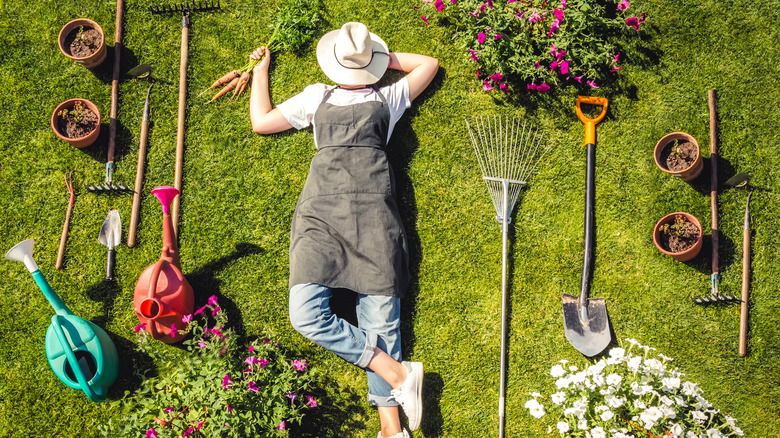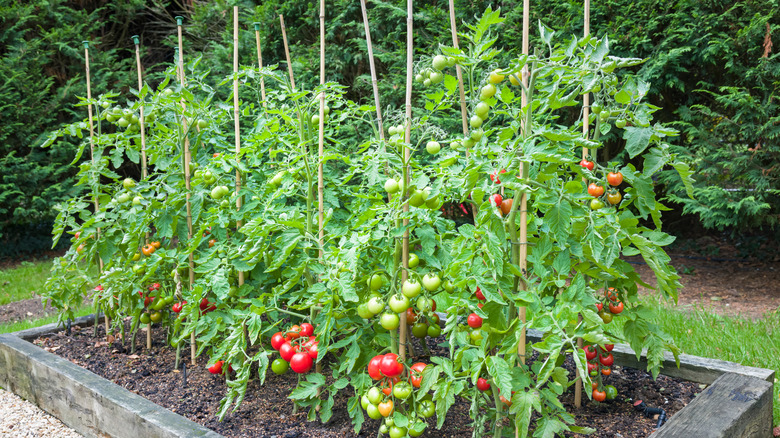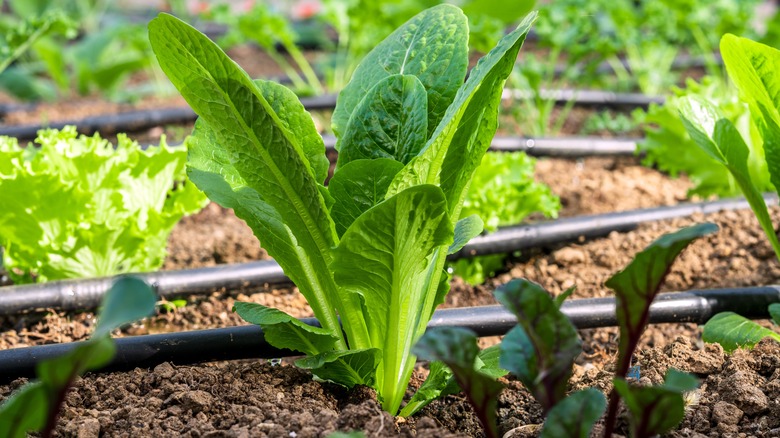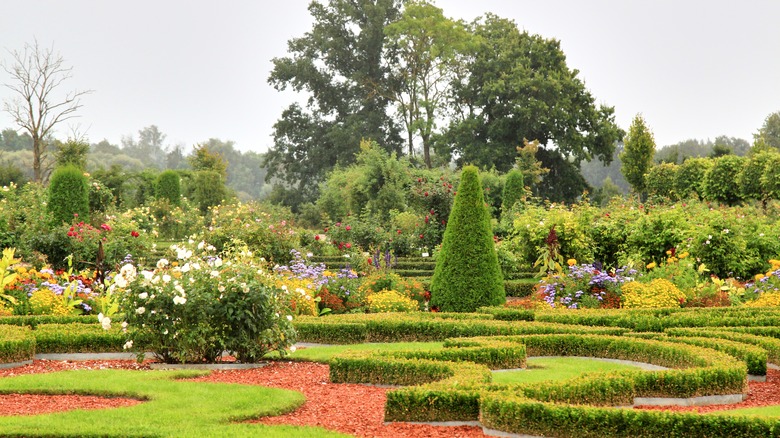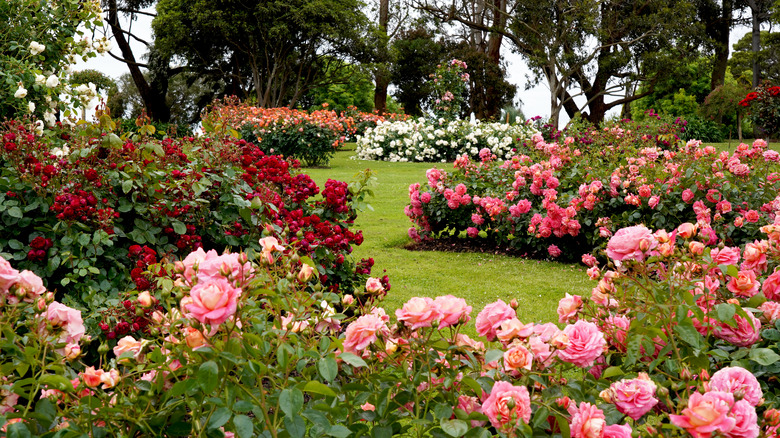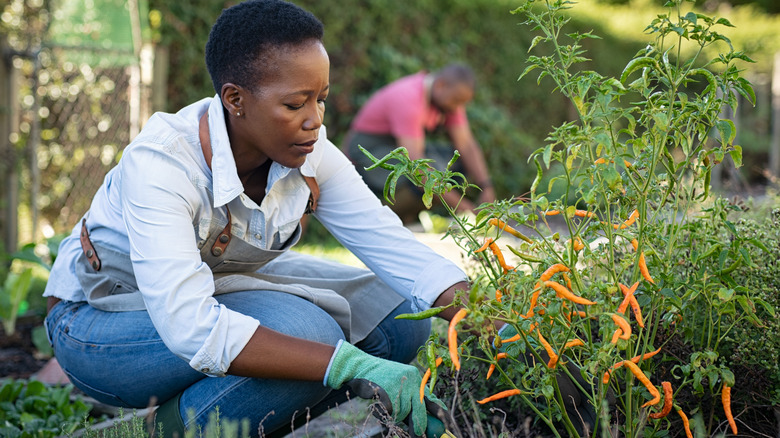How Much Does It Cost To Build A Garden From Scratch
Constructing a new garden from scratch can be a highly rewarding activity for a homeowner. Garden beds, greenhouse installations, and hanging planters can all add to the allure and overall value of a property (via House Beautiful). An established garden is a sight to behold, and the work that goes into making a stunning one will provide you with many hours of relaxation, enjoyment, and a sense of accomplishment that can be hard to find elsewhere.
A number of unique elements go into building a new garden, so it can be hard to pin down an average cost basis for creating the one that will ultimately fit into your yard and life. The best way to understand the overall price tag on a new garden is to start with the dimensions of the space you're hoping to reinvent. A raised garden bed, for instance, averages $145 per bed kit, according to Lawn Starter.
Reimagining your yard to include a garden can be as in-depth a process as you want it to be. Simple changes, like the addition of a single raised garden bed, can make for a new look and feel in your yard, while more substantial renovations to the lawn will reimagine the entire energy of the space and provide you with ample growing area to support a drive toward self-sustaining living and a greener thumb.
Factors for cost
Adding a garden to your yard can provide a whole new feature and great enjoyment to your home. Because of the varied ways in which a homeowner can install a new garden, making this change a dramatic one or a more subdued addition is totally up to you. No matter how you approach building a new garden, many of the cost factors remain the same.
Landscaping begins with a plan and the removal of features
For a homeowner looking to revamp their garden, the first step is to understand what it is that the new garden will try to accomplish. Every garden is unique; some act as a growing medium for vegetables, fruit, and other plants that will serve in the kitchen or pantry, and other gardens offer an extended grassy area that's perfect for children's playtime or relaxation.
Typically, when building a new set of landscaping features, the first thing you'll need to do is remove existing elements of the space. Raking out sod, removing trees and leftover stumps, or digging up shrubs and bushes to make room for new additions can be backbreaking work. Hiring a professional outlet to complete these tasks will cost you between $50 and $100 per hour (for a two-person team), according to Forbes Advisor.
Adding fertile soil to the yard or in raised beds features prominently in the cost analysis
Adding growing plant life to your garden is something that many homeowners look forward to when creating a new yard layout, but growing a vibrant garden of flowers, fruit trees, or vegetables will require an expansive use of fertile soil. HomeAdvisor estimates that topsoil typically runs between $12 and $55 per cubic yard, while sand costs between $15 and $40 per cubic yard.
Hunker points out that prices can vary dramatically across the country, advising homeowners to assume a local price that comes in at the high end. Furthermore, Hunker suggests that a 4-inch depth that covers 1,000 square feet of new garden space will require 12 cubic yards of soil, costing $660 at the high-end price point. If you're looking to establish raised garden beds, the volume requirement may be even more substantial depending on the depth of each container's space.
It's also a good idea to invest in worms to support ongoing health in the soil of your garden. The dirt that acts as a growing medium for your plants is a complex mixture of various components and worms help to ensure that this blend of organic materials is always balanced with the right nutrients for healthy plant growth. Worm Farming Secrets estimates that you should expect to spend around $50 or $55 on composting worms that can be added directly to the soil or used in a specialized compost additive maker called a vermicomposter or wormery (via the U.S. Environmental Protection Agency).
Working with a landscape designer can boost the overall cost of the project
Homeowners that don't know where to start on a new garden project can benefit greatly from the introduction of a landscape designer and their specialized expertise. Forbes Advisor estimates that the average cost of a landscaper runs about $700, with a significant range that extends from as little as $50 for simple lawn care tasks to more than $7,000 for a total makeover. Factoring in a cost of at least $1,000 will bring you closer to an overall estimate of the price if you opt to bring in a landscaper to help make the transformation.
These professionals can offer their expertise in both the changes that need to be made and in selecting the perfect site on your property for a new garden. Moving back to the initial planning phase, if you're unsure of how to go about this change, then working with a landscaper can help you design a strategy that will take you from start to finish in a streamlined fashion.
Additional costs
In addition to the direct costs of redesigning your yard to include a garden section, there are a number of other cost factors that can play a role in the final price.
Many gardens feature structures like raised beds, hanging baskets, and even greenhouses
The attractiveness of specialized garden features make them a favorite among homeowners looking to install new garden fixtures on their property. Raised garden beds, trellises, greenhouses, frames, and many other features play a significant role in the transformation of a yard into a garden. But these additions will raise the price of the endeavor.
Better Homes & Gardens explains that an arched trellis is a great addition to just about any garden because it offers the ability to segment the landscaping into two distinct areas. These fixtures allow you to create a luxurious feel to the garden while adding a functional piece to the equation that can be used for vines and other plants that require support to reach their full potential. A Rustic Garden offers iron arbors and arched trellises at prices ranging from $379.95 up to about $1,000.
Another often-seen option is the raised garden bed. Garden beds can be made from wood, metal, and many other materials. Lawn Starter estimates that raised garden beds range from $104.18 to $210.46 per bed, with framing materials costing an average of $18.39 per square foot.
Greenhouse installations (via House Digest) will also add to the cost of the project. A typical greenhouse kit (not including those that are custom built with a foundation and more permanent status on the property) will cost between $1,000 and $2,000 (via Greenhouse Info).
The plants themselves will raise the cost of construction
In addition to the cost of equipment and the construction of planting areas, homeowners looking to create a new garden bed for their home will have to factor in the cost of the plants themselves. Plant prices can vary greatly depending on the types of plants you are hoping to install in the garden. Seeds (for flowers, herbs, fruits, and more) often cost a few dollars per packet, with heirloom seeds typically priced around the $3 mark per packet (via Baker Creek Heirloom Seeds). On the other hand, trees, large shrubs, and specialty plants can raise the price. Bob Vila reports that homeowners can expect to spend $150 to $300 per tree for smaller or younger varieties, and about 10 times that ($1,500 to $3,000) for large trees that measure over 15 feet.
Increased watering needs will raise your bill accordingly
Lastly, adding a new garden will increase your irrigation needs. Routine watering of this space that is specifically designed for increased growth can dramatically change your water usage and overall sprinkler system layout. Angi estimates that a simple drip irrigation installation can be found for as little as $22, whereas a professional installation can cost between $450 and $625.
Additionally, depending on your price for water, an irrigation system can raise your monthly water bill — either by a small factor or a more substantial one. For homeowners worried about significantly increased water costs, installing a rainwater system to support your needs might be the perfect solution. HomeAdvisor estimates that a straightforward, single-barrel system will likely cost around $120, but a more elaborate setup can cost upwards of $2,500.
Types of home gardens
There are endless ways that you can establish a growing area at your house. Garden design is completely up to you; however, many people find that by following an existing blueprint for some of the most popular garden layouts, they can enjoy the space and experiences that it can provide with greater regularity and effectiveness.
Density-minded urban gardens
In North America, 83.6% of the population lived in cities in 2020, according to the World Economic Forum. In practice, this means that most Americans looking to incorporate garden space into their home will need to do so in an urban environment rather than with a sprawling rural landscape as a backdrop. The Royal Horticultural Society notes that urban balconies and yard space are often marked by high walls and sometimes the addition of densely packed buildings surrounding the space. Making use of plants that can thrive in shady areas is a must if your area doesn't see full sun through the bulk of the day.
Formal gardens
Gardening Know How recommends a formal garden for anyone who thrives on clean lines and meticulously planned design elements. These layouts are based on geometric symmetry and offer a sense of powerful serenity. A formal garden can be as large or small as you want, making this a great choice for homeowners seeking to install a unique and eye-catching piece to the outdoor space of their property.
Plant-specific gardens
Many people choose to plant specialized gardens that focus on a single kind of crop or growing method. The addition of an herb garden, vegetable garden, or even a small home grove of fruit trees, vines, or bushes can add something special to your home. Home Stratosphere suggests that a vegetable garden is one of the most popular options for homeowners seeking to make this change to their property. Vegetable gardens are easy to care for and they provide a product that grows quickly and can make a difference in your kitchen in as little as just a few months.
Why you need a garden on your property
Adding a garden to your property provides a brand new feature that enhances the home in many ways. For one, garden space can create a defining element that brings you and your family outdoors on a more consistent basis. Building a garden with additional relaxation features integrated directly into the space can provide an even greater effect that flows through the entire home, not just the exterior space.
Added relaxation is a standard for homeowners enjoying the gardening-enhanced lifestyle
The Spruce tells of backyard transformation that can enhance your mood and ability to unwind at the end of a long day. The backyard provides the foundation for much of the relaxation that many people enjoy in their homes. Adding a garden to this area (or on the front end of the home) completes the overall vision of peace and tranquility that so many homeowners seek with their landscaping and outdoor furniture additions.
Garden space can dramatically improve your ability to relax in the outdoor areas of your home. The American Psychological Association reports that exposure to nature can improve emotions and mood as well as attention. Your garden can provide a safe haven for the family and it easily establishes a fantastic place to relax and enjoy a unique element of the home.
Gardens beautify the home, boosting resale value as well as quality of life
In addition to the relaxation effect that a garden can provide, focusing on the exterior space and improving the landscaping can boost the resale value of your home. A study conducted by the Virginia Tech Extension reports that the often-cited 15% boost in resale value is accurate, and in the United Kingdom, a well-kept garden can increase your property's value by as much as 77%, according to research conducted by Post Office Money (via House Beautiful).
Benefits of a home garden
UNC Health reports that a garden can add more than financial and lifestyle improvements to your home. On top of these added features, gardening provides potent health benefits, too.
Gardening is great for developing finer hand-eye coordination and other motor skills
The physical tasks associated with gardening provide a low-intensity form of exercise that many people can integrate into their lifestyle without difficulty. But for those with mobility issues or other considerations, gardening can also be done at a height with the use of raised beds or custom-built greenhouse space, making the endeavor something that can be shared by virtually everyone. Digging, planting, and watering your crop takes patience and a measure of physical labor. These tasks typically won't require extensive strength to accomplish but rather fine movements and precision.
Children's programming often incorporates gardening as a means to develop these critical skills as well (via Brain Balance Centers), making time spent in the garden something that both young and old alike can share and enjoy. Incorporating this hobby into your lifestyle can change the way you approach minute detail and tasks requiring enhanced hand-eye coordination.
Gardeners enjoy reduced stress and improved heart health
Something that comes up regularly when speaking about outdoor activity is the increased heart health that comes into play. UNC Health outlines a reduction in stress (including anxiety, depression, and other related factors that play a role in mental wellbeing) and a boost to heart and lung health among a number of important benefits that can be felt through the task of gardening.
